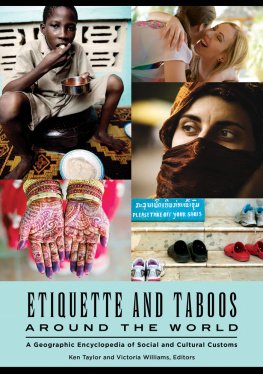Etiquette and Taboos
around the World
Etiquette and
Taboos around
the World
A Geographic Encyclopedia of
Social and Cultural Customs
KEN TAYLOR AND VICTORIA WILLIAMS,
EDITORS

Copyright 2017 by ABC-CLIO, LLC
All rights reserved. No part of this publication may be reproduced, stored in a retrieval system, or transmitted, in any form or by any means, electronic, mechanical, photocopying, recording, or otherwise, except for the inclusion of brief quotations in a review, without prior permission in writing from the publisher.
Library of Congress Cataloging-in-Publication Data
Names: Taylor, Ken, 1953- editor. | Williams, Victoria, editor.
Title: Etiquette and taboos around the world : a geographic encyclopedia of
social and cultural customs / Ken Taylor and Victoria Williams, editors.
Description: Santa Barbara, California : Greenwood, An Imprint of ABC-CLIO,
LLC, 2017. | Includes bibliographical references and index. |
Identifiers: LCCN 2017016819 (print) | LCCN 2017021772 (ebook) |
ISBN 9781440838217 (ebook) | ISBN 9781440838200 (alk. paper)
Subjects: LCSH: EtiquetteEncyclopedias. | TabooEncyclopedias.
Classification: LCC BJ1815 (ebook) | LCC BJ1815 .E86 2017 (print) |
DDC 395.03dc23
LC record available at https://lccn.loc.gov/2017016819
ISBN: 978-1-4408-3820-0
EISBN: 978-1-4408-3821-7
21 20 19 18 17 1 2 3 4 5
This book is also available as an eBook.
Greenwood
An Imprint of ABC-CLIO, LLC
ABC-CLIO, LLC
130 Cremona Drive, P.O. Box 1911
Santa Barbara, California 93116-1911
www.abc-clio.com
This book is printed on acid-free paper 
Manufactured in the United States of America
Contents
Spanish-Speaking Caribbean: Puerto Rico and the
Dominican Republic
Preface
Every culture on Earth has its own etiquette, by which is meant the traditional code of respectful behavior that members of a society or group are expected to follow. Etiquette is then the moderating force that balances the desire of individuals to act upon their own instincts with the need to yield to social conventions. It is necessary for individuals to uphold the etiquette of their society in order to ensure that their society functions harmoniously. Etiquette differs between societies and cultures, however, and this encyclopedia attempts to cover the dos and donts of the etiquette found in many countries and major ethnic groups around the world.
As this book concentrates on etiquette adhered to by societies and cultures worldwide, some of the entries may be familiar to American readers, such as the entries on European or African American etiquette. Other entries, meanwhile, may be less familiar to American readers, such as the entries on the Pashtuns living in Afghanistan and Pakistan, the Uyghurs of Eastern and Central Asia, and Chinas Hui people. While the entries contained in this book demonstrate the variety of different etiquette rules adhered to by the people of various cultures, the entries also highlight some common etiquette rules found across the world. These commonalities include the need to address people correctly during introductions and the taboo surrounding eating with the left hand found in Islamic societies across the globe.
The scope of this book takes in North, Central, and South America; Europe; Africa; Asia; the Middle East; and Oceania. The entries cover etiquette followed by men, women, and children in all manners of social situations, though they focus mainly on the etiquette of introductions and greetings, dress codes, hospitality and dining etiquette, guidelines surrounding body language and verbal communication, and the social conventions around online networking and interaction (so-called netiquette). Though the entries are obviously concerned with codes of social behavior, they also include elements of history, politics, religion, folklore, and sociology. The books introduction looks at the history of etiquette and considers different academic perspectives (including sociological, scientific, and linguistic) on the subject.
Though this book is primarily aimed at student researchers, the writing has been kept as jargon-free as possible so that the general reader can also enjoy the book from cover to cover for entertainment or if wishing to learn about the etiquette of travel destinations. However, with the researcher in mind, every entry can be looked at as a stand-alone item and each entry is followed by a brief Further Reading list. There is also a Selected Bibliography at the back of the book.
We would like to thank our international team of dedicated contributors for their input when preparing this book, for they have provided great insight into the rich variety of world etiquette and social customs. Most importantly of all, however, the writing of this publication would not have been possible without the constant enthusiasm of Kaitlin Ciarmiello, acquisitions editor at ABC-CLIO.
Victoria Williams and Ken Taylor
Introduction
Etiquette is a code of behavior that defines expected, conventional social behavior according to contemporary norms within certain cultures, classes, and groups of people. The word etiquette derives from the Old French word estiquette (or estiquet) meaning to attach, to stick, or to fix. Indeed the modern understanding of the word etiquette can be traced back to the royal court of French King Louis XIV (16381715), who employed small placards called etiquettes as reminders to courtiers of the behavior expected at court, such as remembering not to walk in particular areas of the palace gardens. This instance is quite unusual, however, as etiquette rules are not normally written down but rather may be collated periodically. Etiquette can shape many aspects of peoples social interactions and may indicate a societys fundamental code of ethics as well as an individuals status within a society. It should be noted, however, that while the words ethics and etiquette stem from the Greek root ethike (meaning character), the two terms are not interchangeable. Ethics is a philosophical consideration of the morals and values that govern peoples actions, whereas etiquette is the code of conventional, correct behavior that exists in a society.
The history of etiquette can be traced back much further than the time of Louis XIV. In the third millennium BCE, a collection of sebayt (teachings) and advice called The Maxims of Ptahhotep was produced, apparently written by the ancient Egyptian vizier Ptahhotep who wished to instruct his son about the subject of human relations. Four papyrus copies of the work survive, though the only complete version is the Prisse Papyrus dating from the Middle Kingdom that is on display at the Bibliothque Nationale in Paris, France. In the introduction to The Maxims of Ptahhotep, the author explains that he wishes to pass on the knowledge of his ancestors. This knowledge appears as 37 maxims or guidelines that do not set out a complete code of morality but rather stress the importance of certain secular virtues such as the need for honesty tempered by discretion, self-discipline, moderation in all things, compassion, generosity, and integrity. The Maxims of Ptahhotep also suggests that it is best to learn by listening to others, and that avoiding conflict should be seen as a virtue rather than as a sign of cowardice or weakness. Other instructions included in the work relate to how to act in the presence of people of higher social ranks. At the same time, however, the maxims suggest it is necessary to practice the virtues of compassion, generosity, integrity, and so on to all human beings whatever their station in life.
Next page








